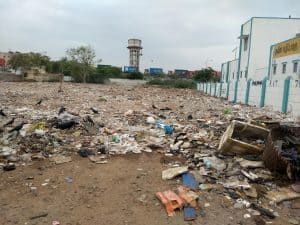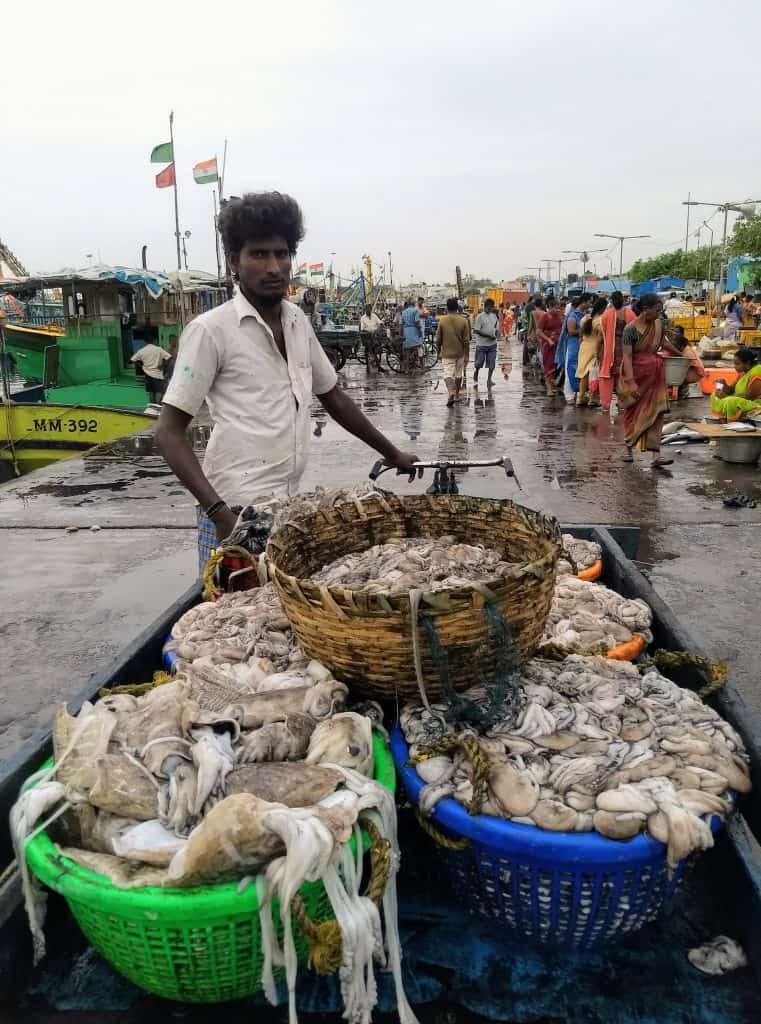A whiff of fresh air greets visitors at Kasimedu beach. The relaxing sound of the waves hitting the groynes does a good job of soothing stressed or anxious minds.
Even as early as 5 am, the wharf at the Kasimedu harbour bustles with activity: visitors (yes, there are visitors at that hour, trying out fishing ropes) try and snag a fish, youngsters click a round of selfies and men and women take a stroll. A few yards from the wharf is the market, where you can hear the shrill voices of fisherwomen tempting customers with a description of the fish varieties on sale. As a fisherwoman indulges in a brawl with another for luring away the former’s customer, the latter swears ripely.
Where business flourishes
For the common Chennaiite, Kasimedu fishing harbour is a recreational site, where fish – of all sizes and shapes – can be bought at dirt cheap rates. For the fishermen, it is all about the math.
The harbour has 1500 mechanised boats, receives 30,000 visitors and generates 150 tonnes of seafood everyday. “The volume of business (including wholesale and exports) amounts to an estimated Rs 1.5 crore each day. More than 15 tonnes of fish are exported through flight service to foreign countries including Malaysia, Iran, Iraq, Dubai and Singapore,” says Nangil P Ravi, Working President, All India Fishermen Union.
But let us keep the economics aside for the moment, did you know that the history of Kasimedu dates back to the 18th century and has a strong connection with the Vijayanagara empire? The history of this market is captivating and historians are still unearthing new facets.
How boatmen turned fishermen
The name Kasimedu is relatively new, as the fishing hamlet was part of Royapuram till about sixty years ago. The first settlers in Royapuram were the migrants from Durgarajapattinam (called Armagoam by the British), that was ruled by the Vijayanagara empire.
Located south of Pulicat and north of Madras, the coastal village of Durgarajapattinam was where the British planned to commence their trade. “The coast was rough and hard to navigate, and it hindered their plans of constructing a port for trade. The British gave up their plans, moved to Madras and brought along four families from Armagoam, promising them work,” says Nivedita Louis, a history enthusiast.
The four families, belonging to the clan called Gurukula Vamsha Varnakula Mudaliyars, were primarily boatmen. After settling in Chepauk village, they took to constructing, mending and plying Masula boats, a type of boat used on the eastern coast of India. “They used the boats to ferry things and people between the ship and the coast, since there was no harbour. When the British decided to shift the Customs House from Fort St George to Black town, the boatmen were shifted to a locality close to Black town in 1788. The place was later called Royapuram, after Royappa Chapel,” explains Nivedita.
Origin of Kasimedu
Originally mostly Hindus, the Durgarajapattinam clan converted to Christianity and sought permission from the British for constructing a church. Thus Royappa Church and eventually, Royapuram emerged. But, the boatmen were left jobless once the Madras harbour was constructed in the late 18th century.
“The boatmen now got into fishing for a living. A part of Royapuram gradually came to be referred to as Kasimedu. There is no recorded document about the origin of Kasimedu; literally, medu means an elevated surface. The coast is elevated due to the sand dunes,” says Nivedita, connecting the dots.
According to historian V Sriram, the name could also have come from the Kasi Viswanathan temple. “The gopuram of the temple was seen in the waters, from the shore till 15 years ago. Though no documents are available to prove it, one can correlate it with the temple’s name,” says Sriram. The historian recollected having seen the temple’s picture as signature shots of the DD Tamil news bulletin.
Despite the combined efforts of many historians, several structures in the harbour continue to remain unfathomable, for example, the grey, concrete pillar at Kasimedu.
Current status
To improve the quality of lives of the fishermen at Kasimedu, former Chief Minister M G Ramachandran constructed a harbour in 1975. Only after the harbour was constructed did Kasimedu become famous and much more accessible to many fishermen.
Four years ago, in a proposal to modernise Chennai’s fishing markets, a sum of Rs 100 crores was allocated by former Chief Minister J Jayalalithaa. Kasimedu market was constructed using a part of those funds, while many other markets in the proposal are still awaiting modernisation.
Fishermen are however reluctant to shift into the market, even though it reportedly has all the required amenities. They sell fish in the scorching heat and in unhygienic conditions, yet they believe that their business would never flourish in a closed market.

Fish waste and other plastic waste dumped at an empty plot behind the Kasimedu market. Pic: Laasya Shekhar
“We can’t start afresh. Our voice is our weapon, as we call out to customers and persuade them to buy fish, which is impossible in closed quarters,” says Mariamma Joseph, who sells prawn and fish. On the other hand, the fishermen union has requested the government to take adequate steps to counsel the fraternity and bring them to sell in the closed market.
Indifferent to their legacy and unfazed by mounting problems, the inhabitants of Kasimedu continue with their lives. While the men set sail on the choppy sea to find a good catch, women take charge of selling it for a price that will be sufficient to feed their families.


